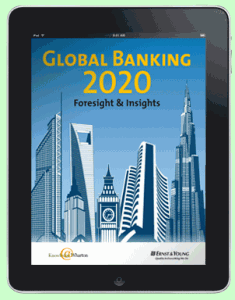 Global bank executives face the highest levels of uncertainty in decades. More onerous regulations, rising funding costs and non-traditional competitions – such as from telecoms anxious to take over mobile transactions — are just a few of the challenges making it difficult for bankers to plan with any confidence in the post-financial crisis environment.
Global bank executives face the highest levels of uncertainty in decades. More onerous regulations, rising funding costs and non-traditional competitions – such as from telecoms anxious to take over mobile transactions — are just a few of the challenges making it difficult for bankers to plan with any confidence in the post-financial crisis environment.
One way to cope with so much volatility is to plot out scenarios or alternate futures – including extreme ones – and then to create strategies to manage each one. Wharton faculty, Ernst & Young executives and global bankers – 20 participants in all — have worked out such scenario-based strategies for global banks over the next eight to 10 years. The results are available in a free video-enhanced eBook: Global Banking 2020: Foresight & Insights, published this week.
In this first-ever video-enhanced eBook on global banking, the three groups use a structured scenario-planning process to outline four alternate futures and to recommend practical steps that global bank executives can take now to prepare for them. Devising strategies to address all four scenarios, including where banks might find growth opportunities, also prepares bank executives to manage through the range of scenarios that fall between the four outlined, according to the findings in the enhanced eBook.
The four scenarios outlined in the eBook are as follows:
- Business as Usual — involves a modest shift of economic power to emerging markets, no financial crises or unmanageable sovereign debt issues and little non-traditional banking competition (telecoms, retailers or online/mobile transaction-services companies),.
- Financial Issues — anticipates more burdensome regulations than in the first scenario, and some financial crises, although central banks should be able to contain them.
- New Markets – envisions much greater economic power for emerging markets and financial crises that severely test central banks.
- Change, Change, Change – this scenario projects large growth opportunities in emerging markets, but also extensive disruption, highly burdensome regulations, widespread financial crises and strong competitive challenges from nontraditional banking providers such as telecoms, retailers and online financial transaction services companies.
Some strategies recommended in the study apply to one, two or three of the scenarios. But the planning group also identified several strategies that global banks could implement right away that apply across the board. They include the following:
- Gain a beachhead now in emerging markets which offer the best opportunities for growth.
- Ramp up IT spending to get a clear window into data — not simply to comply with regulations, but also to boost performance and develop new products and services.
- Develop a nimble culture: With profit margins likely to be tight for years, bankers need to be ready to shift resources rapidly among markets and to create new business models with speed-to-market.
- Focus on non-balance-sheet intensive business lines: The regulatory environment will almost certainly remain volatile, and regulations will likely vary significantly between jurisdictions. Non-balance sheet-intensive activities are less likely to trigger reserve requirements.
- Emphasize cost controls for the long term, including for compensation.
The eBook offers findings around each of these four scenarios. The eBook can be downloaded for free in the Apple iBookstore and on Amazon, and viewed on an iPad, iPhone, or iTouch using the Apple iBookstore app or the Kindle app. It also is available for viewing over the web on a PC, and soon will be available through Barnes & Noble on the Color Nook or Tablet.
For details on how to download (or view on the web) Global Banking 2020: Foresight & Insights, see: #.



